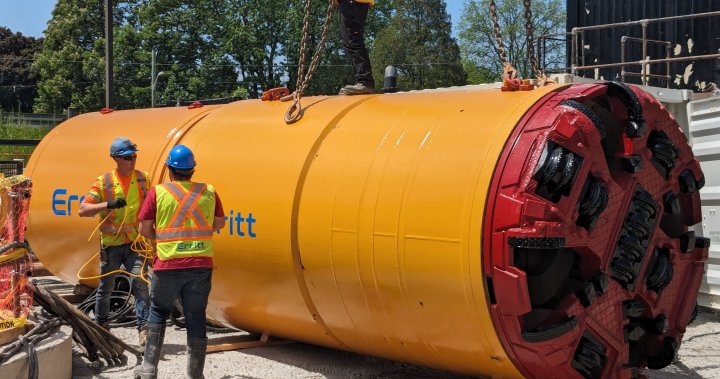A major construction project in London involving the use of an 80,000-pound drill is underway to replace and increase sewer capacity in the downtown area. The project, which is estimated to cost $7.4 million, involves replacing 800 meters of trunk sewer and increasing capacity to accommodate infill development, housing targets, and wet weather flows. The sewer replacement project will also tie into the West London Dyke reconstruction, providing additional benefits to the area’s infrastructure. The existing trunk sanitary sewer, located near the river, needs to be moved and increased in size to make way for the West London Dyke project.
The drill being used for the project belongs to Erritt Construction and is valued at over $2 million. It will be used to drill 6 meters below the ground for a total length of 68 meters under Wharncliffe Road, from Cavendish Crescent to Riverside Park. This process, known as microtunneling, is one of the trenchless technologies being employed by the city to install infrastructure without disrupting the road network, driveways, and parks. Once completed, the new pipe will be one of the largest in London. The machine functions by rotating the head and sending high-pressure water through feed nozzles to break up rocks, clay, and other materials in front of the head. The separated materials are filtered and recirculated, while the dirt, mud, and rocks are sent to a muck pit.
London Mayor Josh Morgan was present at the construction site when the drill was lifted, emphasizing the importance of the project for the city. The project is expected to triple the downtown area’s wastewater capacity to the Greenway Treatment Plant, enabling residential densification and improved management of heavy rainfalls. The entire project is projected to be completed by June 2025, with no specific timeline provided for the drilling process. However, based on the speed of 15 centimeters per hour, it is estimated to take a few weeks to complete. The City’s Get Involved website contains more information about the project for interested stakeholders.
The construction project in London utilizing the 80,000-pound drill is a crucial infrastructure initiative aimed at replacing and increasing sewer capacity in the downtown area. With an estimated cost of $7.4 million, the project involves replacing 800 meters of trunk sewer and enhancing capacity to support various development needs in the city. By increasing capacity, the project will facilitate infill development, meet housing targets, and reduce overflows to the Thames River during wet weather events. Additionally, the project will link to the West London Dyke reconstruction, contributing to the overall improvement of the area’s infrastructure.
The drill, owned by Erritt Construction and valued at over $2 million, is being utilized for drilling under Wharncliffe Road from Cavendish Crescent to Riverside Park. Through microtunneling technology, the drill operates by rotating the head and sending high-pressure water to break up materials in front of the head, ensuring minimal disruption to surrounding areas. Once complete, the new pipe will significantly increase London’s sewer capacity and become one of the largest in the city. London Mayor Josh Morgan emphasized the project’s significance, as it will triple downtown wastewater capacity, support residential densification, and enhance stormwater management capabilities.
The project is scheduled for completion by June 2025, with the drilling process expected to take a few weeks based on an average speed of 15 centimeters per hour. Mayor Josh Morgan highlighted the importance of the project, stating that it will have a transformative impact on the city’s infrastructure and allow for more sustainable urban development. For further details on the project, interested individuals can visit the City’s Get Involved website to stay informed and engaged with the ongoing construction activities. The overall project aims to address critical infrastructure needs, improve sewer capacity, and enhance the overall resilience of London’s downtown area to future challenges and growth opportunities.


